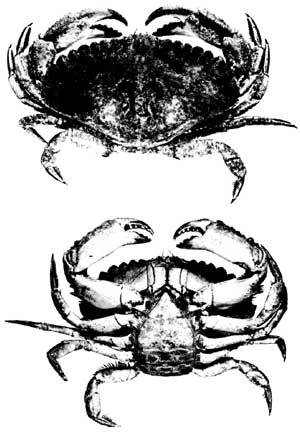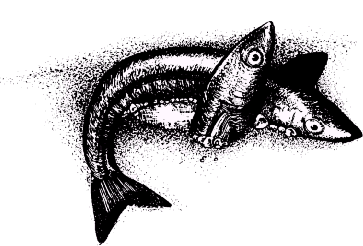Long Range Fish Report
From Sportfishing
From Sportfishing
Fish Report for 2-20-2014

California Outdoors Q & A: Taking One Claw From Crabs?
2-20-2014
California Department of Fish & Wildlife
California Department of Fish & Wildlife
Marine Management News
NEWS RELEASE
FOR IMMEDIATE RELEASE - February 20, 2014
California Outdoors Q & A: Taking One Claw From Crabs?
Question: Our fishing club is planning a fishing trip for local crab out of the Santa Monica Bay area. Some people in the group insist we should only keep one claw from each crab so they can be put back to grow another claw and still live. I know with lobsters we are instructed to leave them whole until they are ready for consumption to allow the wildlife officer to verify it's a legal catch. Is it legal to keep only one claw or do we need the entire crab to allow the wildlife officer to verify? (Jerry E.)
Answer: You are required to take the whole legal-sized crab to prove your crab is of legal size. Possessing just claws would be a violation because the size of the crabs they came from cannot be determined (Fish and Game Code, Section 5508). Crabs also carry a lot of meat in the body. Crab season for all crabs of the genus Cancer (except Dungeness crabs) is open all year. The size limit in Southern California is four inches and the part of the crab that we measure is the main body shell (edge of shell to edge of shell at the widest part).
While crabs may be able to regenerate lost claws under good conditions, crabs with only one claw have a far tougher time fending off predators than if they had both claws for protection. Predators will go after any weakened animal, so just removing a claw may be considered a waste of fish - also a state violation.
Question: There will be three of us going to Catalina to hoop for lobsters with a multi-day permit. One guy will only be able to hoop two of the three days and then will have to take the Flyer back to go to work. Can my friend and I transport this guy's catch back for him as long as we have his license/report card with us without being in violation of limits? He will not be able to take his catch with him. (Larry H.)
Answer: No. Multi-day permits require that "All passengers must disembark at place of return as stated" on the permit (California Code of Regulations Title 14, Section 27.15(b)(5)). Your friend can "gift" you his lobsters, but they will count towards your overall take/possession limit. You and your friend are allowed to take/possess only your own limits. In this situation, your friend must go home with his catch or else all three of you are allowed to catch no more than a limit for two people.
Question: What should a person do when approached by a wildlife officer for inspection? Should they put the gun onto their car so that it's in plain sight? Should they tell the officer to wait while they unload the gun? Should they place the gun on the ground? What is the proper protocol in this type of situation? Please advise. (Rheannon O.)
Answer: First of all, placing a loaded long gun in or on a vehicle which is in a place open to the public is a violation of the law. Vehicles should automatically be considered a poor choice to place or to store a loaded firearm. When a wildlife officer approaches, the first thing you should do is follow the directions that the officer gives you. Absent any directions, here are some good options:
Some people unload their firearm in a calm manner to show respect for what a loaded firearm can do, and respect for the officer. This shows the officer you are handing him a safe unloaded firearm. If you are within talking distance, ask the officer if he/she wants you to unload the firearm. If directed to unload, make sure to control the muzzle so it points away from people.
Many folks simply hand the firearm to the officer, and that is also acceptable. If you do, make sure to tell the officer the gun is loaded.
Setting the gun on the ground is acceptable so long as the muzzle is pointed in a safe direction, but depending on the terrain (mud, sand, etc.), this may not be a prudent choice.
Question: Can you apply for a deer drawing if you are only 11 but will be 12 before the hunt starts, or do you have to be 12 before you put in for the drawing? (Jacob W.)
Answer: You must be 12 years old by July 1 to apply.
Carrie Wilson is a marine biologist with the California Department of Fish and Wildlife. She cannot personally answer everyone's questions but will select a few to answer in this column each week. Contact her at CalOutdoors@wildlife.ca.gov.
Photos and all archived columns: http://californiaoutdoors.wordpress.com
CDFW Marine Management News
Ocean-related news and information
Visit the Marine Region Website at www.dfg.ca.gov/marine
California Department of Fish and Wildlife
Box 944209
Sacramento CA 94244
Marine Management News
NEWS RELEASE
FOR IMMEDIATE RELEASE - February 20, 2014
California Outdoors Q & A: Taking One Claw From Crabs?
Question: Our fishing club is planning a fishing trip for local crab out of the Santa Monica Bay area. Some people in the group insist we should only keep one claw from each crab so they can be put back to grow another claw and still live. I know with lobsters we are instructed to leave them whole until they are ready for consumption to allow the wildlife officer to verify it's a legal catch. Is it legal to keep only one claw or do we need the entire crab to allow the wildlife officer to verify? (Jerry E.)
Answer: You are required to take the whole legal-sized crab to prove your crab is of legal size. Possessing just claws would be a violation because the size of the crabs they came from cannot be determined (Fish and Game Code, Section 5508). Crabs also carry a lot of meat in the body. Crab season for all crabs of the genus Cancer (except Dungeness crabs) is open all year. The size limit in Southern California is four inches and the part of the crab that we measure is the main body shell (edge of shell to edge of shell at the widest part).
While crabs may be able to regenerate lost claws under good conditions, crabs with only one claw have a far tougher time fending off predators than if they had both claws for protection. Predators will go after any weakened animal, so just removing a claw may be considered a waste of fish - also a state violation.
Question: There will be three of us going to Catalina to hoop for lobsters with a multi-day permit. One guy will only be able to hoop two of the three days and then will have to take the Flyer back to go to work. Can my friend and I transport this guy's catch back for him as long as we have his license/report card with us without being in violation of limits? He will not be able to take his catch with him. (Larry H.)
Answer: No. Multi-day permits require that "All passengers must disembark at place of return as stated" on the permit (California Code of Regulations Title 14, Section 27.15(b)(5)). Your friend can "gift" you his lobsters, but they will count towards your overall take/possession limit. You and your friend are allowed to take/possess only your own limits. In this situation, your friend must go home with his catch or else all three of you are allowed to catch no more than a limit for two people.
Question: What should a person do when approached by a wildlife officer for inspection? Should they put the gun onto their car so that it's in plain sight? Should they tell the officer to wait while they unload the gun? Should they place the gun on the ground? What is the proper protocol in this type of situation? Please advise. (Rheannon O.)
Answer: First of all, placing a loaded long gun in or on a vehicle which is in a place open to the public is a violation of the law. Vehicles should automatically be considered a poor choice to place or to store a loaded firearm. When a wildlife officer approaches, the first thing you should do is follow the directions that the officer gives you. Absent any directions, here are some good options:
Some people unload their firearm in a calm manner to show respect for what a loaded firearm can do, and respect for the officer. This shows the officer you are handing him a safe unloaded firearm. If you are within talking distance, ask the officer if he/she wants you to unload the firearm. If directed to unload, make sure to control the muzzle so it points away from people.
Many folks simply hand the firearm to the officer, and that is also acceptable. If you do, make sure to tell the officer the gun is loaded.
Setting the gun on the ground is acceptable so long as the muzzle is pointed in a safe direction, but depending on the terrain (mud, sand, etc.), this may not be a prudent choice.
Question: Can you apply for a deer drawing if you are only 11 but will be 12 before the hunt starts, or do you have to be 12 before you put in for the drawing? (Jacob W.)
Answer: You must be 12 years old by July 1 to apply.
Carrie Wilson is a marine biologist with the California Department of Fish and Wildlife. She cannot personally answer everyone's questions but will select a few to answer in this column each week. Contact her at CalOutdoors@wildlife.ca.gov.
Photos and all archived columns: http://californiaoutdoors.wordpress.com
CDFW Marine Management News
Ocean-related news and information
Visit the Marine Region Website at www.dfg.ca.gov/marine
< Previous Report Next Report >
More Reports
California Department of Fish & Wildlife Reports
for Wednesday, February 19th, 2014
• California Fish Plants
• 2014 Predicted Grunion Run Schedule Now Available
California Department of Fish & Wildlife Reports
for Tuesday, February 18th, 2014• California Outdoors Q & A: Can a Private Boat Owner Be Cited for a Passenger's Violation?

LongRangeSportfishing.net © 2025. All Rights Reserved.
Website Hosting and Design provided by TECK.net
Website Hosting and Design provided by TECK.net